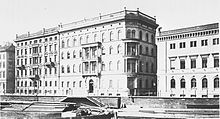Hotel d'Angleterre (Berlin)
The Hotel d'Angleterre (also called Englischer Hof ) was a first-class hotel in the Prussian (later German) capital Berlin in the 19th century . It was not far from the Berlin City Palace on the square at the Bauakademie (later called Schinkelplatz ) at number 2. The hotel was built in 1857/58 right next to the already existing Hotel de Russie (place at Bauakademie No. 1). Both hotels were demolished in 1894/95 and replaced by a bank administration building.
A sought-after hotel
In Robert Springer's Berlin Guide, the Hotel d'Angleterre is listed among the first-class Berlin hotels in 1861. This is also the case with Kapp in his Berlin Guide from 1869, where the hotel is described as "very much wanted".
A privileged location
At that time, the so-called " Alte Packhof " (a busy customs warehouse that had been across the street until 1832) had long since been demolished and replaced by the representative Schinkelplatz, where the building academy built by Karl Friedrich Schinkel was located. This opened up a delightful view of the new Schlossbrücke (also built by Schinkel and adorned with magnificent statues) as well as the houses of the Schloss Freiheit in front of the Berlin City Palace and the palace from the street at the Bauakademie (as the old Niederlagstrasse was now called) self.
The architect of the new Hotel d'Angleterre, Eduard Titz, describes the location of the new hotel in 1859 as follows: "The building, located in the most beautiful part of Berlin, affords an extremely imposing view from the nearby castle bridge. From the windows of the bedrooms you have a splendid view of the great surroundings of the hotel, whose location for tourism can be described as a very happy one. " Even the Baedeker in 1887 explicitly pointed out the "excellent location" of the hotel.
Selling to a bank
At the beginning of the 1880s, the Bank für Handel und Industrie began to be interested in the location on Schinkelplatz. She first acquired the house at Schinkelplatz No. 3 and rented the house at Schinkelplatz No. 4. In 1890 she was also the owner of the properties No. 1 (Hotel de Russie) and No. 2 (Hotel d'Angleterre). She had both hotel buildings torn down in 1894/95 and replaced by a large bank administration building that spanned both properties.
New locations
The operation of the Hotel d'Angleterre initially continued. He moved to a building at Friedrichstrasse 191, where the hotel was reopened in 1896 under the director A. Tuchenhagen (1900: director P. Häring). In its new location, the hotel, the building of which belonged to the government councilor H. Höpner, was at the intersection of Friedrichstrasse and Kronenstrasse in an urban area that had significantly fewer tourist attractions than the previous location.
After another move, the hotel was continued in 1906 at Kochstrasse 75. The building in which the Hotel d'Angleterre was housed at that time belonged to the merchant Ch. Eisenberg. The owner of the hotel was Friedrich Krawatzki. Obviously this location did not prove itself either. In 1909 the Hotel d'Angleterre is no longer listed in the business directory of the Berlin address book.
The former location today
Built on the site of the hotel building from 1858 on Schinkelplatz Bank office building, which later Danatbank used (Darmstädter- and National Bank), was for the bankruptcy of the bank for German industrial bonds (later German Industrial Bank) adopted, was in World War II by Allied bombings destroyed. The ruins initially gave way to the GDR Foreign Ministry. After it was demolished, the area between the Friedrichswerder Church / simulation of the building academy and the rebuilt headquarters on Unter den Linden remained a green area for a long time. From 2014 the site will be built on again.
literature
- Karl Baedeker : Berlin and surroundings. Guide for travelers. 5th edition, Verlag Karl Baedeker, Leipzig 1887.
- KL Kapp: Berlin in 1869. New and complete guide with special consideration for traffic, trade, industry, art and the public. Life. Published by KL Kapp, Berlin 1869.
- Robert Springer: Berlin. A guide to the city and its surroundings. Verlag JJ Weber, Leipzig 1861.
- Volker Wagner: The Dorotheenstadt in the 19th century. From the suburban residential area of the baroque style to part of Berlin's modern city. (= Publications of the Historical Commission in Berlin , Volume 94.) Verlag de Gruyter, Berlin / New York 1998, ISBN 3-11-015709-8 .
Individual evidence
- ↑ cf. Robert Springer: Berlin. A guide to the city and its surroundings. Verlag II Weber, Leipzig 1861, p. 80.
- ↑ cf. KL Kapp: Berlin in 1869. KL Kapp publisher, Berlin 1869, p. 204.
- ↑ * 1819 in Reichenberg (Bohemia), † 1890 in Berlin.
- ↑ cf. Karl Baedeker: Berlin and the surrounding area. Verlag Karl Baedeker, 13th edition Leipzig 1904, p. 13.
Coordinates: 52 ° 31 '0.5 " N , 13 ° 23' 53" E



